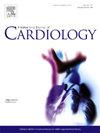25-year follow-up on marked ventricular repolarization abnormalities in athletes: Long-term outcomes and cardiovascular prognosis
IF 3.2
2区 医学
Q2 CARDIAC & CARDIOVASCULAR SYSTEMS
引用次数: 0
Abstract
Background
The presence of ventricular repolarization abnormalities (VRA) in young asymptomatic athletes is rare and may represent initial expression of underlying ongoing cardiomyopathy, increasing risk of sudden cardiac death. This study aims to evaluate the long-term prognosis of VRAs in this specific population.
Methods
A cohort of 28 young asymptomatic Caucasian male athletes with VRA on 12‑leads electrocardiogram (ECG), initially underwent transthoracic echocardiography (TTE) and treadmill test between1990–2000 which excluded cardiac diseases. The same tests where repeated between 2021 and 2023, after a 25-year follow-up period. Cardiac magnetic resonance (CMR) was also prescribed in 6 selected cases. VRA were described as T-wave inversion (TWI) and it was categorized into three different patterns based on the distribution of TWI on ECG.
Results
After 25-years follow-up, all subjects remained alive without major cardiac adverse events. Among them, 11 % developed significant structural changes suggestive of underlying cardiomyopathy, including 3 (11 %) cases of hypertrophic cardiomyopathy. All pathological cases exhibited VRA Type 2 pattern (isolated TWI in left precordial leads) or Type 3 patterns (diffuse TWI in precordial leads ± some or all limb leads). However, the most common VRA pattern observed at the beginning of the study was characterized by isolated right precordial leads TWI (type 1) associated with ST-segment elevation, which was characterized by an uneventful follow-up.
Conclusion
Marked abnormal repolarization in young asymptomatic athletes with Type 1 pattern, in the absence of structural abnormalities, is highly associated with benign outcomes during long-term follow-up. The presence of diffuse or left precordial TWI (VRA Type 2 or 3) should be carefully evaluated, as it is related with cardiomyopathy development.
Summary
A follow-up of 28 young Caucasian male athletes initially identified with VRA on routine ECG, without evidence of structural heart disease. The study delineates the incidence of cardiomyopathy development and assesses cardiovascular outcomes over an extended period of 25 years follow-up.
背景:在无症状的年轻运动员中出现心室复极化异常(VRA)的情况非常罕见,这可能是潜在的心肌病的初期表现,会增加心脏性猝死的风险。本研究旨在评估这一特殊人群中 VRA 的长期预后:方法:在 1990-2000 年期间,28 名无症状的年轻白种男性运动员在 12 导联心电图(ECG)上出现 VRA,他们最初接受了经胸超声心动图(TTE)和跑步机测试,排除了心脏疾病。经过 25 年的随访,在 2021 年至 2023 年期间再次进行了相同的测试。对 6 例选定病例还进行了心脏磁共振(CMR)检查。VRA 被描述为 T 波倒置(TWI),并根据 TWI 在心电图上的分布分为三种不同的模式:随访 25 年后,所有受试者均健在,未发生重大心脏不良事件。其中,11%的受试者出现了提示潜在心肌病的明显结构变化,包括 3 例(11%)肥厚型心肌病。所有病理病例均表现出 VRA 2 型模式(左心前区导联中的孤立 TWI)或 3 型模式(心前区导联中的弥漫性 TWI ± 部分或全部肢体导联)。然而,在研究开始时观察到的最常见的 VRA 模式是孤立的右心前导联 TWI(1 型),伴有 ST 段抬高,其特点是随访顺利:结论:在没有结构异常的情况下,无症状的年轻运动员出现明显的 1 型再极化异常与长期随访的良性结果密切相关。应仔细评估是否存在弥漫性或左心前区 TWI(VRA 2 型或 3 型),因为这与心肌病的发展有关。摘要:该研究对 28 名年轻的白种男性运动员进行了随访,这些运动员最初在常规心电图上被发现患有 VRA,但没有心脏结构性疾病的证据。该研究描述了心肌病的发病率,并评估了 25 年长期随访的心血管结果。
本文章由计算机程序翻译,如有差异,请以英文原文为准。
求助全文
约1分钟内获得全文
求助全文
来源期刊

International journal of cardiology
医学-心血管系统
CiteScore
6.80
自引率
5.70%
发文量
758
审稿时长
44 days
期刊介绍:
The International Journal of Cardiology is devoted to cardiology in the broadest sense. Both basic research and clinical papers can be submitted. The journal serves the interest of both practicing clinicians and researchers.
In addition to original papers, we are launching a range of new manuscript types, including Consensus and Position Papers, Systematic Reviews, Meta-analyses, and Short communications. Case reports are no longer acceptable. Controversial techniques, issues on health policy and social medicine are discussed and serve as useful tools for encouraging debate.
 求助内容:
求助内容: 应助结果提醒方式:
应助结果提醒方式:


